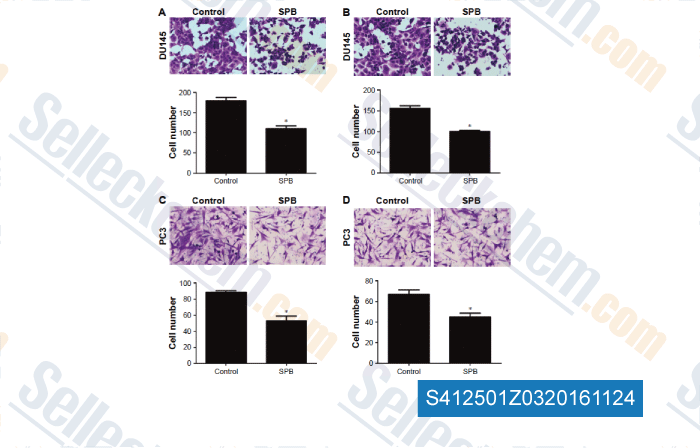|
Toll Free: (877) 796-6397 -- USA and Canada only -- |
Fax: +1-832-582-8590 Orders: +1-832-582-8158 |
Tech Support: +1-832-582-8158 Ext:3 Please provide your Order Number in the email. |
Technical Data
| Formula | C10H11O2.Na |
|||
| Molecular Weight | 187.19 | CAS No. | 1716-12-7 | |
| Solubility (25°C)* | In vitro | DMSO | 37 mg/mL (197.66 mM) | |
| Water | 37 mg/mL (197.66 mM) | |||
| Ethanol | Insoluble | |||
|
* <1 mg/ml means slightly soluble or insoluble. * Please note that Selleck tests the solubility of all compounds in-house, and the actual solubility may differ slightly from published values. This is normal and is due to slight batch-to-batch variations. * Room temperature shipping (Stability testing shows this product can be shipped without any cooling measures.) |
||||
Preparing Stock Solutions
Biological Activity
| Description | 4-PBA (Sodium Phenylbutyrate) is a salt of 4-phenylbutyrate (4-PBA) or 4-phenylbutyric acid.Sodium phenylbutyrate is a histone deacetylase inhibitor, used to treat urea cycle disorders. | |
|---|---|---|
| Targets |
|
|
| In vitro | Phenylbutyrate is a well-known HDAC inhibitor, which increases gene transcription of a number of genes, and also exerts neuroprotective effects. Phenylbutyrate significantly attenuates MPTP-induced depletion of striatal dopamine and loss of tyrosine hydroxylase-positive neurons in the substantia nigra. [1] Phenylbutyrate attenuates the expression of the apoptosis antagonist Bcl-X(L), the double-strand break repair protein DNA-dependent protein kinase, the prostate progression marker caveolin-1, and the pro-angiogenic vascular endothelial growth factor in prostate cancer cells. Phenylbutyrate is found to act in synergy with ionizing radiation to induce apoptosis in prostate cancer cells. [2] |
|
| In vivo | Phenylbutyrate significantly extends survival and improved both the clinical and neuropathological phenotypes in G93A transgenic ALS mice. Phenylbutyrate administration ameliorates histone hypoacetylation observed in G93A mice and induced expression of nuclear factor-kappaB (NF-kappaB) p50, the phosphorylated inhibitory subunit of NF-kappaB (pIkappaB) and beta cell lymphoma 2 (bcl-2), but reduced cytochrome c and caspase expression. Phenylbutyrate acts to phosphorylate IkappaB, translocating NF-kappaB p50 to the nucleus, or to directly acetylate NF-kappaB p50. [3] Phenylbutyrate increases brain histone acetylation and decreased histone methylation levels as assessed by both immunocytochemistry and Western blots in a transgenic mousemodel of Huntington's disease (HD). Phenylbutyrate increases mRNA for components of the ubiquitin-proteosomal pathway and down-regulated caspases implicated in apoptotic cell death, and active caspase 3 immunoreactivity in the striatum. [4] |
Protocol (from reference)
| Cell Assay: |
|
|---|---|
| Animal Study: |
|
References
Customer Product Validation

-
Data from [Data independently produced by , , OncoTargets and Therapy, 2016, 9:2825-2833.]
Selleck's 4-PBA (Sodium Phenylbutyrate) has been cited by 18 publications
| Regulation of Hsa-miR-4639-5p expression and its potential role in the pathogenesis of Parkinson's disease [ Aging Cell, 2023, 22(6):e13840] | PubMed: 37101349 |
| Pharmacological heat-shock protein inducers and chemical chaperones inhibit upregulation of interleukin-8 by oxidized phospholipids [ Inflammopharmacology, 2023, 31(3):1319-1327] | PubMed: 36692663 |
| Endoplasmic reticulum stress contributes to cisplatin-induced chronic kidney disease via the PERK-PKCδ pathway [ Cell Mol Life Sci, 2022, 79(8):452] | PubMed: 35895146 |
| Reciprocal regulation between ER stress and autophagy in renal tubular fibrosis and apoptosis [ Cell Death Dis, 2021, 12(11):1016] | PubMed: 34716302 |
| ATF3 contributes to brucine-triggered glioma cell ferroptosis via promotion of hydrogen peroxide and iron [ Acta Pharmacol Sin, 2021, 10.1038/s41401-021-00700-w] | PubMed: 34112960 |
| Artesunate induces ER-derived-ROS-mediated cell death by disrupting labile iron pool and iron redistribution in hepatocellular carcinoma cells [ Am J Cancer Res, 2021, 11(3):691-711] | PubMed: 33791148 |
| Verteporfin Is a Promising Anti-Tumor Agent for Cervical Carcinoma by Targeting Endoplasmic Reticulum Stress Pathway [ Front Oncol, 2020, 10:1781] | PubMed: 33014875 |
| Depending on the stress, histone deacetylase inhibitors act as heat shock protein co-inducers in motor neurons and potentiate arimoclomol, exerting neuroprotection through multiple mechanisms in ALS models. [ Cell Stress Chaperones, 2020, 25(1):173-191] | PubMed: 31900865 |
| The novel ALK inhibitor ZX-29 induces apoptosis through inhibiting ALK and inducing ROS-mediated endoplasmic reticulum stress in Karpas299 cells [ J Biochem Mol Toxicol, 2020, e22666] | PubMed: 33140567 |
| Melatonin Increases the Sensitivity of Hepatocellular Carcinoma to Sorafenib through the PERK-ATF4-Beclin1 Pathway. [ Int J Biol Sci, 2019, 15(9):1905-1920] | PubMed: 31523192 |
RETURN POLICY
Selleck Chemical’s Unconditional Return Policy ensures a smooth online shopping experience for our customers. If you are in any way unsatisfied with your purchase, you may return any item(s) within 7 days of receiving it. In the event of product quality issues, either protocol related or product related problems, you may return any item(s) within 365 days from the original purchase date. Please follow the instructions below when returning products.
SHIPPING AND STORAGE
Selleck products are transported at room temperature. If you receive the product at room temperature, please rest assured, the Selleck Quality Inspection Department has conducted experiments to verify that the normal temperature placement of one month will not affect the biological activity of powder products. After collecting, please store the product according to the requirements described in the datasheet. Most Selleck products are stable under the recommended conditions.
NOT FOR HUMAN, VETERINARY DIAGNOSTIC OR THERAPEUTIC USE.
